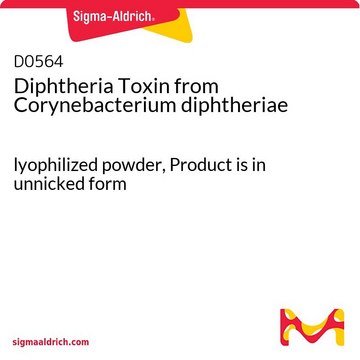T3194
Tetanus toxin
from Clostridium tetani, cleaves synaptobrevin (VAMP-2)
About This Item
Prodotti consigliati
Nome del prodotto
Tetanus toxin from Clostridium tetani,
PM
150 kDa (heavy chain (100 kDa) and a light chain (50 kDa) connected through an interchain disulfide bond)
Livello qualitativo
Solubilità
H2O: soluble
Temperatura di conservazione
2-8°C
Informazioni sul gene
Clostridium tetani E88 ... tetX(1061100)
Descrizione generale
Applicazioni
Azioni biochim/fisiol
Nota sulla preparazione
Ricostituzione
Risultati analitici
Avvertenze
Danger
Indicazioni di pericolo
Consigli di prudenza
Classi di pericolo
Acute Tox. 1 Oral - Acute Tox. 2 Inhalation - STOT SE 1
Organi bersaglio
Central nervous system
Codice della classe di stoccaggio
6.1A - Combustible acute toxic Cat. 1 and 2 / very toxic hazardous materials
Classe di pericolosità dell'acqua (WGK)
WGK 3
Punto d’infiammabilità (°F)
Not applicable
Punto d’infiammabilità (°C)
Not applicable
Dispositivi di protezione individuale
Eyeshields, Faceshields, Gloves, type P3 (EN 143) respirator cartridges
Scegli una delle versioni più recenti:
Possiedi già questo prodotto?
I documenti relativi ai prodotti acquistati recentemente sono disponibili nell’Archivio dei documenti.
I clienti hanno visto anche
Il team dei nostri ricercatori vanta grande esperienza in tutte le aree della ricerca quali Life Science, scienza dei materiali, sintesi chimica, cromatografia, discipline analitiche, ecc..
Contatta l'Assistenza Tecnica.













